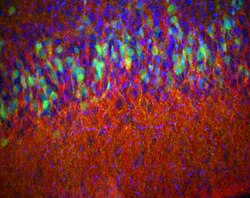| Paleocortex | |
|---|---|
 Piriform cortex from a 14-day-old D2-eGFP (green) mouse stained for enkephalin (red) and DAPI (blue) to show nuclei. Epifluorescence. | |
| Details | |
| Part of | Cerebral cortex |
| Identifiers | |
| Latin | paleocortex |
| NeuroNames | 2336 |
| NeuroLex ID | nlx_143559, birnlex_1097 |
| TA98 | A14.1.09.303 |
| TA2 | 5531 |
| TE | E5.14.3.4.3.1.33 E5.14.3.4.3.1.34, E5.14.3.4.3.1.33 |
| FMA | 62430 |
| Anatomical terms of neuroanatomy | |
In anatomy of animals, the paleocortex, or paleopallium, is a region within the telencephalon in the vertebrate brain.[1] This type of cortical tissue consists of three cortical laminae (layers of neuronal cell bodies).[2] In comparison, the neocortex has six layers and the archicortex has three or four layers.[3] Because the number of laminae that compose a type of cortical tissue seems to be directly proportional to both the information-processing capabilities of that tissue and its phylogenetic age, paleocortex is thought to be an intermediate between the archicortex (or archipallium) and the neocortex (or neopallium) in both aspects.[1][4]
The paleocortex (or paleopallium) and the archicortex (or the archipallium) of the cerebral cortex together constitute the mammalian allocortex or the heterogenetic cortex. The distinction for what is called neocortex or isocortex, which comprises most of the human brain (about 90%), is made from the number of cellular layers that the structure comprises. Neocortical tissue comprises six distinct cell layers, not seen in paleocortical tissues either in adult or developing stage.
In humans the paleocortex is exemplified in the olfactory cortex. For most vertebrates, the olfactory bulb is the main feature of the paleocortex,[5] even though the division is virtually unused outside of a mammalian context.
- ^ a b Cite error: The named reference
Purves 2011was invoked but never defined (see the help page). - ^ Purves, Dale; Augustine, George J; Fitzpatrick, David; Hall, William C; LaMantia, Anthony-Samuel; White, Leonard E (2011). Neuroscience (5th ed.). Sinauer Associates Inc. p. 666. ISBN 9780878936465.
- ^ Purves et al: Neuroscience 3rd Edition, 2004, page 617
- ^ "Paleocortex". BrainInfo. University of Washington. Retrieved 5 May 2013.
- ^ Taniguchi, K (June 2014). "Phylogenic studies on the olfactory system in vertebrates". The Journal of Veterinary Medical Science. 76 (6): 781–8. doi:10.1292/jvms.13-0650. PMC 4108759. PMID 24531771. S2CID 17625152.
